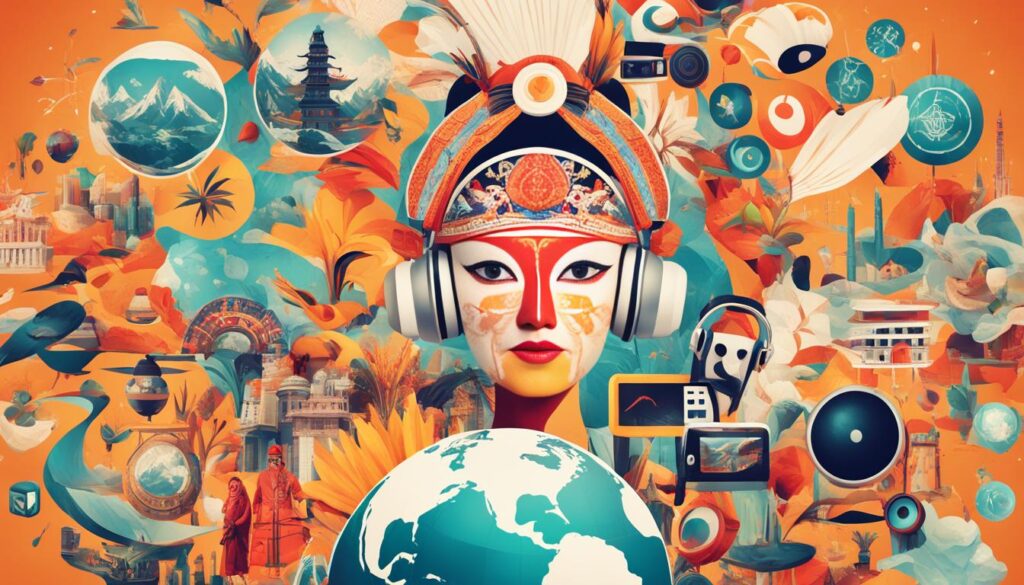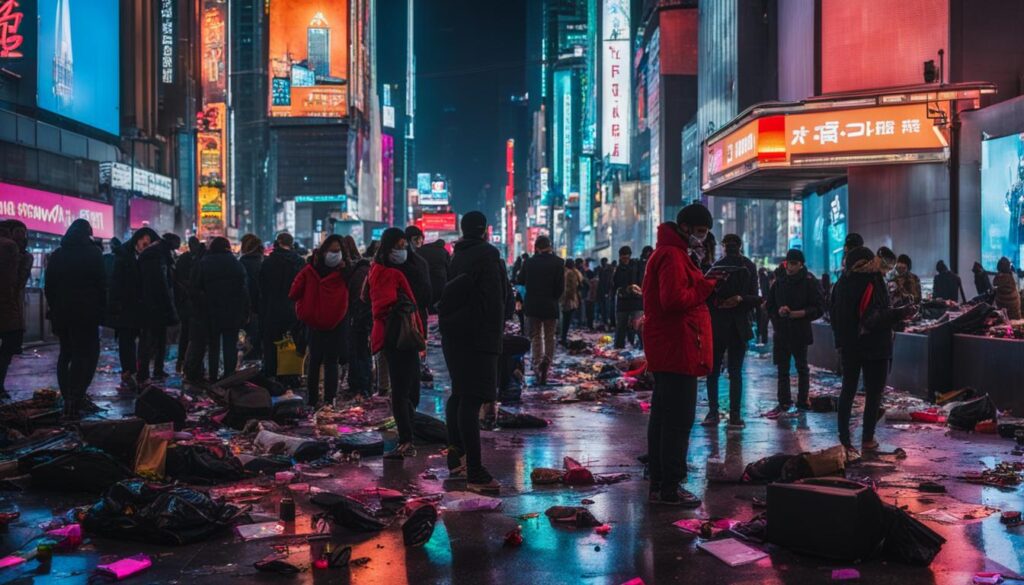
The influence of modern technology on culture is extensive, shaping the way we communicate, create, and consume cultural content. From language and art to mobility and education, technology has revolutionized society and played a significant role in cultural evolution. However, it is essential to understand both the positive and negative effects of technology on culture.
Technological advancements have brought about substantial cultural shifts, with new technologies influencing various aspects of culture. From the internet and social media facilitating global cultural exchange to the rise of digital art and online platforms for music and film, technology has redefined how we create and consume cultural content.
While technology can help preserve cultural heritage through digital archiving and virtual reality, there is a concern about the erosion of traditional practices and the homogenization of culture as people rely more on digital platforms. The way we consume cultural content has also been transformed with the advent of digital media, such as streaming services and e-books.
On the positive side, technology has facilitated cultural exchange on a global scale, enabling cross-cultural understanding and collaboration. However, this comes with challenges, including the digital divide and the overshadowing of local customs and traditions by global culture. It is crucial to address these concerns to ensure technology’s impact on culture is positive and inclusive.
Key Takeaways:
- Modern technology has revolutionized culture, transforming the way we communicate, create, and consume cultural content.
- Technological advancements have led to significant cultural shifts, influencing language, art, mobility, and more.
- Technology can both preserve and erode traditional practices, requiring a delicate balance.
- The rise of digital media has changed how we consume cultural content, raising concerns about the devaluation of cultural products.
- Technology has facilitated global cultural exchange, promoting cross-cultural understanding, but also poses challenges such as the digital divide.
Technological Advancements and Cultural Shifts
Technological advancements have had a profound impact on culture, leading to significant shifts in various aspects of society. The introduction of new technologies has revolutionized the way people communicate, create, and consume cultural content. This has resulted in cultural changes and a reimagining of traditional practices.
One area where technology has greatly influenced culture is language. The advent of the internet and social media has facilitated the rapid exchange of cultural ideas and practices on a global scale. People from different cultures can now connect and communicate, leading to greater cross-cultural understanding. This exchange of ideas has not only impacted language but has also contributed to the spread of global popular culture.
Furthermore, technology has transformed the art world. The rise of digital art has opened up new avenues for creativity, allowing artists to explore and experiment in ways that were not previously possible. Digital platforms provide artists with broader reach and access to global audiences, breaking down barriers and fostering cultural exchange.
Additionally, the shift towards online platforms for music and film has revolutionized the way people create and consume cultural content. Digital platforms have made it easier for individuals to access a wide range of cultural products from around the world, expanding cultural horizons and promoting diversity. However, there are ongoing debates about the impact of this digital shift on cultural diversity and the preservation of traditional practices.
“Technology has transformed the way we experience and interact with culture. It has opened up new possibilities for creative expression and has provided access to a wealth of cultural content from diverse sources. However, we must also be mindful of the potential risks and challenges that come with these advancements, such as the digitization of cultural products and the impact on cultural diversity.”
As technology continues to evolve, it is undeniable that cultural shifts will continue to occur. The effects of technology on culture are complex and multifaceted, with both positive and negative consequences. It is crucial to navigate these changes thoughtfully and consider the preservation of cultural diversity and traditional practices.
Technology’s Impact on Tradition and Preservation
Technology plays a dual role in the preservation and evolution of cultural traditions. On one hand, it provides innovative tools and methods for safeguarding and showcasing cultural heritage. On the other hand, it presents challenges to the authenticity and diversity of traditional practices.
One of the positive impacts of technology on tradition is the ability to preserve cultural heritage through digital means. Digital archiving, virtual reality, and 3D modeling allow historical sites, artifacts, and cultural practices to be documented and shared with a global audience. For example, through virtual museum tours and online exhibitions, people from different corners of the world can explore and appreciate cultural artifacts without being physically present.

This integration of technology and culture also opens up opportunities for interactive experiences. Virtual reality can recreate historical events, enabling users to immerse themselves in traditional ceremonies or rituals. 3D modeling allows the reconstruction of ancient structures, offering a glimpse into the architectural marvels of the past. These advancements not only preserve traditions but also make them accessible to a wider audience, fostering cultural appreciation and understanding.
Despite the benefits, there are concerns about the potential erosion of traditional practices and the homogenization of culture due to the widespread adoption of technology. As people rely more on digital platforms for communication and entertainment, there is a risk of losing the authenticity and distinctiveness of cultural traditions. Traditional forms of art, music, and storytelling may be overshadowed by easily accessible digital content, causing a decline in their practice and appreciation.
Efforts to bridge the digital divide and promote the preservation of cultural traditions are essential for maintaining a balanced relationship between technology and culture. It is crucial to embrace technological advancements while also safeguarding the uniqueness and diversity of traditional practices. By leveraging technology responsibly and consciously, societies can ensure the preservation of cultural heritage for future generations.
| Positive Impact | Negative Impact |
|---|---|
| Preservation of cultural heritage through digital archiving, virtual reality, and 3D modeling | Erosion of traditional practices and the potential homogenization of culture |
| Increased accessibility of cultural artifacts and historical sites to a global audience | Risk of losing the authenticity and distinctiveness of cultural traditions |
| Interactive experiences through virtual reality, allowing users to immerse themselves in traditional ceremonies and rituals | Potential decline in the practice and appreciation of traditional forms of art, music, and storytelling |
Changing Patterns of Cultural Consumption
Technology has revolutionized the way people consume cultural content, leading to significant changes in patterns of cultural consumption. The rise of digital technologies, such as streaming services and e-books, has made it easier for individuals to access a wide range of cultural products from around the world. This shift towards digital consumption has not only provided convenience and accessibility but has also opened up new avenues for cultural exploration and discovery.
With the advent of digital media, individuals can now immerse themselves in diverse cultural experiences without leaving the comfort of their homes. Streaming platforms like Netflix and Spotify have become synonymous with cultural consumption, offering a vast library of movies, series, music, and podcasts. This abundance of digital content gives users the freedom to choose from a plethora of cultural genres, artists, and narratives, expanding their horizons and exposing them to different cultural perspectives.
However, while technology has made cultural content more accessible, it has also raised concerns about the devaluation of cultural products. In the digital age, artists and creators face challenges in monetizing their work and earning a fair income. The ease of online sharing and reproduction of cultural content has led to issues of copyright infringement and piracy, impacting the livelihoods of artists and resulting in a potential loss of cultural diversity.
Moreover, the shift towards digital consumption has had a profound impact on traditional media such as television and newspapers. Traditional forms of cultural content production and dissemination have had to adapt to the changing landscape, embracing digital platforms to reach wider audiences. This shift has also blurred the boundaries between different forms of cultural content, with television shows being streamed online, newspapers transitioning to online news portals, and physical books being replaced by e-books.
“Technology has transformed the cultural consumption landscape, offering unprecedented access to diverse cultural content. However, we must be mindful of the challenges it poses, such as the devaluation of cultural products and the need to ensure fair compensation for artists and creators.”
Despite these challenges, technology continues to shape and evolve cultural consumption patterns, providing new opportunities for cultural exchange and discovery. As digital media and cultural content continue to evolve, it is essential to find a balance that encourages accessibility and innovation while also preserving the value and diversity of cultural experiences.

The Impact of Digital Platforms on Cultural Consumption
The rise of digital platforms has transformed the way people consume cultural content, offering convenience, choice, and interactivity. With just a few clicks, individuals can access a vast array of cultural products, ranging from movies and music to books and artwork, anytime and anywhere. Digital platforms have not only democratized cultural consumption but have also empowered individuals to curate their own cultural experiences.
| Benefits of Digital Platforms for Cultural Consumption | Challenges of Digital Platforms for Cultural Consumption |
|---|---|
|
|
Overall, the changing patterns of cultural consumption driven by technology have both positive and negative implications. While technology has made cultural content more accessible and diverse, it has also posed challenges in terms of fair compensation for artists and the preservation of cultural diversity. As technology continues to advance, it is crucial to address these challenges and ensure that cultural content remains valued, diverse, and accessible to all.
Technology and Cultural Exchange
Technology, particularly the internet and social media, has revolutionized the way cultural exchange takes place on a global scale. It has provided a platform for people from different cultures to connect, learn, and collaborate, leading to greater cross-cultural understanding.
The ease of communication enabled by technology has facilitated the rapid exchange of ideas, cultural practices, and artistic expressions. Through online platforms, individuals can engage in conversations, share experiences, and explore the diversity of global cultures. This has contributed to the spread of global popular culture and the emergence of shared experiences that transcend geographical boundaries.

Technology has made it possible for us to interact with and appreciate cultures from around the world. It has connected us in ways we couldn’t have imagined before. We can learn about different traditions, languages, and perspectives, fostering a deeper understanding and respect for cultural diversity.
– Jane Smith, Cultural Anthropologist
However, the impact of technology on cultural exchange is not without concerns. Global popular culture, driven by digital platforms, has the potential to overshadow local customs and traditions, leading to a homogenization of cultural identities. This raises questions about the preservation of unique cultural practices and the authentic representation of diverse cultural heritage.
Despite these challenges, technology continues to play a crucial role in promoting cultural understanding and breaking down barriers. By embracing the opportunities offered by technology, individuals and communities can engage in cross-cultural dialogue, share perspectives, and bridge cultural divides.
The Role of Social Media
Social media has emerged as a powerful tool for cultural exchange. Platforms such as Facebook, Instagram, and Twitter enable individuals to share their cultural experiences, stories, and artistic creations with a global audience. These platforms foster connections between people from different backgrounds, promoting cultural dialogue and mutual appreciation.
Globalization and Cultural Exchange
Globalization, driven by technological advancements, has significantly influenced cultural exchange. As societies become more interconnected, cultural boundaries blur, creating opportunities for the exchange of ideas, knowledge, and artistic expressions. Global cultural movements and trends are shaped by this exchange, enriching both individual cultures and the global cultural landscape.
Empowering Marginalized Voices
Technology has also provided a platform for marginalized groups to share their unique cultural perspectives. Through online platforms, individuals and communities can amplify their voices, challenge stereotypical portrayals, and reclaim cultural narratives.
Listed below are some notable examples of how technology has facilitated cultural exchange:
- Language learning apps connect individuals from different cultures, promoting language exchange and fostering cross-cultural communication.
- Virtual reality technologies allow individuals to explore immersive cultural experiences and landmarks, providing a glimpse into different cultures.
- Online collaboration tools enable artists and creators from different cultural backgrounds to collaborate on artistic projects, merging diverse artistic styles and influences.
- Podcasts and online radio platforms provide a space for individuals to share their cultural stories, traditions, and experiences with a global audience.
Technology has undoubtedly revolutionized cultural exchange, enabling individuals to connect and engage with cultures from around the world. It has the power to break down barriers, foster cultural understanding, and promote mutual respect.
In the next section, we will delve into the challenges and concerns associated with technology’s impact on culture.
Challenges and Concerns of Technology’s Impact on Culture
While technology has brought numerous benefits to culture, it is not without its challenges and concerns. One significant issue is the digital divide, which refers to the gap between those who have access to technology and those who don’t. This divide can exacerbate cultural inequalities, limiting the participation of certain individuals and communities in global cultural exchanges.
Another concern is the role of technology in the erosion of traditional practices and the homogenization of culture. As technology becomes more prevalent in our daily lives, there is a risk of losing the diversity and distinctiveness of cultural traditions. The rapid spread of global popular culture through digital platforms can overshadow local customs and traditions, leading to cultural homogenization.
Debates also arise surrounding cultural ownership, intellectual property, and the potential misuse of digital cultural assets. With the accessibility and ease of sharing cultural content online, questions arise about who has the right to own and control cultural creations. Protecting intellectual property and preventing the unauthorized use of digital cultural assets becomes vital in preserving cultural heritage and ensuring fair compensation for creators.
“The impact of technology on culture is a double-edged sword. While it has the potential to connect and enrich societies, it also brings challenges that need to be addressed.” – Professor Jane Smith, Cultural Anthropologist
Addressing these challenges and concerns is crucial to ensuring that technology’s impact on culture remains positive and inclusive. Efforts should be made to bridge the digital divide and provide equal access to technology for all individuals and communities. Additionally, it is essential to promote the preservation of cultural diversity and traditional practices in the face of technological advancements.
| Challenges | Concerns |
|---|---|
| Digital divide | Erosion of traditional practices |
| Cultural inequalities | Homogenization of culture |
| Cultural ownership | Misuse of digital cultural assets |

By recognizing and addressing these challenges and concerns, we can harness the power of technology to preserve and celebrate diverse cultures while fostering innovation and positive cultural exchanges.
How has music technology influenced modern culture?
Understanding music technology basics has revolutionized modern culture. From digital music production to streaming services, technology has transformed the way we create, consume, and share music. It has also influenced the way we experience live performances and interact with artists, shaping modern society’s relationship with music.
Conclusion
In conclusion, modern technology has significantly impacted culture, reshaping the way people communicate, create, and consume cultural content. It has fostered greater connectedness and cross-cultural understanding, enabling individuals to engage with diverse perspectives and experiences. However, this technological revolution also presents challenges and concerns that need to be addressed.
One of the main challenges is the erosion of traditional practices. As technology becomes more pervasive, there is a risk of losing cultural diversity and distinctiveness. It is important to strike a balance between embracing the benefits of technology and preserving cultural values and traditions.
Another concern is the digital divide, which creates inequalities between those who have access to technology and those who do not. Bridging this gap is crucial to ensure that everyone can participate in global cultural exchanges and benefit from technological advancements.
By addressing these challenges and fostering inclusivity, technology can contribute to positive social change and innovation in the cultural sphere. It is essential to find ways to preserve cultural diversity, support local practices, and ensure that technology enhances cultural understanding rather than overshadowing it.








